Unlocking Efficiency with Automatic Roll Forming Machines

Automatic roll forming machines are integral to modern manufacturing, specifically within the realm of metal fabrication. These machines employ a continuous bending process to create complex shapes from metal sheets or strips, effectively optimizing production lines. The automation aspect of these machines allows for increased consistency, speed, and safety, which are critical in today’s competitive manufacturing landscape.
One of the primary advantages of using an automatic roll forming machine is its ability to carry out complex profiles with minimal manual intervention. This results in reduced labor costs and improved product quality. The seamless operation of these machines enables manufacturers to produce long lengths of material without interruption. Furthermore, the precision achieved through automated processes minimizes waste, ensuring that resources are optimally utilized.
When considering the implementation of an automatic roll forming machine, it is crucial to understand the various components that contribute to its functionality. Key features often include adjustable roll stations, which allow operators to modify the shape of the material according to specific requirements, and a computerized control system that facilitates precise adjustments for different production runs. This level of flexibility is essential for manufacturers who need to adapt quickly to changing market demands.
Additionally, automatic roll forming machines are designed to handle a variety of materials, from galvanized steel to aluminum. This versatility allows manufacturers to cater to diverse industries, including construction, automotive, and appliance manufacturing. The ability to create different profiles—such as C-sections, Z-sections, and channels—is particularly beneficial for companies looking to diversify their product offerings.
Moreover, advancements in technology have led to features such as energy-efficient motors and integrated safety systems, further enhancing the appeal of these machines. By investing in an automatic roll forming machine, manufacturers not only improve their operational efficiency but also contribute to sustainable practices by reducing energy consumption and material waste.
In conclusion, the adoption of automatic roll forming machines is a strategic move for manufacturers aiming to enhance productivity and maintain a competitive edge. The benefits of automation, precision, and versatility underscore the importance of integrating these machines into production processes. As industries continue to evolve, the role of automatic roll forming machines will undoubtedly grow, leading to innovative applications and improved manufacturing standards.
One of the primary advantages of using an automatic roll forming machine is its ability to carry out complex profiles with minimal manual intervention. This results in reduced labor costs and improved product quality. The seamless operation of these machines enables manufacturers to produce long lengths of material without interruption. Furthermore, the precision achieved through automated processes minimizes waste, ensuring that resources are optimally utilized.
When considering the implementation of an automatic roll forming machine, it is crucial to understand the various components that contribute to its functionality. Key features often include adjustable roll stations, which allow operators to modify the shape of the material according to specific requirements, and a computerized control system that facilitates precise adjustments for different production runs. This level of flexibility is essential for manufacturers who need to adapt quickly to changing market demands.
Additionally, automatic roll forming machines are designed to handle a variety of materials, from galvanized steel to aluminum. This versatility allows manufacturers to cater to diverse industries, including construction, automotive, and appliance manufacturing. The ability to create different profiles—such as C-sections, Z-sections, and channels—is particularly beneficial for companies looking to diversify their product offerings.
Moreover, advancements in technology have led to features such as energy-efficient motors and integrated safety systems, further enhancing the appeal of these machines. By investing in an automatic roll forming machine, manufacturers not only improve their operational efficiency but also contribute to sustainable practices by reducing energy consumption and material waste.
In conclusion, the adoption of automatic roll forming machines is a strategic move for manufacturers aiming to enhance productivity and maintain a competitive edge. The benefits of automation, precision, and versatility underscore the importance of integrating these machines into production processes. As industries continue to evolve, the role of automatic roll forming machines will undoubtedly grow, leading to innovative applications and improved manufacturing standards.
Key words:
Previous Page
Previous Page:
recommend News
Share



